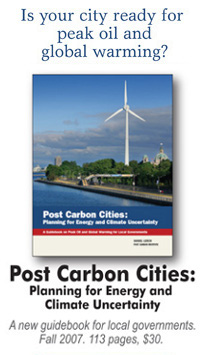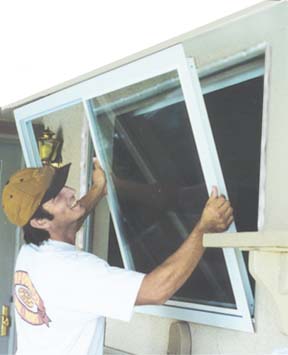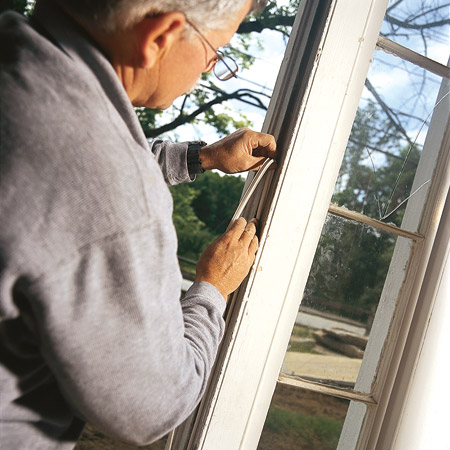

___________________Home____________________

Click image
above for ordering information.
It is time for citizens to get involved. And it is past times for our governmental bodies to get involved. Learn as much as you can about these issues. Urge your city, county, Florida, and national leadership to do their jobs, and prepare society for the kind of changes we are facing.

Floridians
spend more than 4 billion dollars on energy each year.
Here are some ways
to save money without spending a fortune...
Upgrade to modern windows. Super windows, filled with
argon or krypton gas and covered with a special film, are up to 12 times
more efficient than regular windows. Yet they still look like normal glass.
These windows, which are widely available, buffer noise and prevent ultraviolet
light from fading carpets, upholstery, drapes and art. They also cut down
on drafts caused by ordinary windows.
 A window rated R-7
or better -- meaning the window has seven times the insulating value of
a single pane of glass -- will gain more heat in the winter than it loses,
even when it faces north, and conversely will retain interior cooling
even when facing south.
A window rated R-7
or better -- meaning the window has seven times the insulating value of
a single pane of glass -- will gain more heat in the winter than it loses,
even when it faces north, and conversely will retain interior cooling
even when facing south.
Check the web or Yellow Pages under "Windows."
Cost: 15% to 50% more than regular double-pane windows. They can pay for
themselves in less than a decade, and some utility companies offer rebates.
Average price for a standard-sized superwindow: $175.
Install Thermal barrier window film as an alterntive.
For a cost of roughly $1 to 2.00 a square foot, treated adhesive film
will limit infra-red, UV1 and UV2 solar radiation. More expensive films
also incorporate tear resistance which reinforce windows during windstorms,
and provide extra security.
Install heat barriers. In hot climates, a radiant barrier
placed above attic insulation can reduce cooling costs by up to 15%. This
plastic film has an aluminum coating on one side that reflects heat from
the sun and can save up to $80 a year. Cost: 10 cents to 45 cents per
square foot installed. A heat barrier pays for itself in as little as
10 years in the average Florida home.
Repair heating/cooling systems. Air escaping from ducts
can reduce heating, ventilation and air-conditioning (HVAC) efficiency
by up to 20%. Sealing the seams can save $300 of a typical household's
annual $1,400 energy bill.
Hire an HVAC contractor to seal your ducts for $500 to $900. Or do it
yourself if the ducts are accessible in the attic or crawl space. Check
your ducts every 10 years. Use mastic, a high-strength adhesive that is
applied with a trowel or brush. Cost: $10 to $15 per gallon. A typical
house might require five gallons. Mastic is available at home-improvement
stores and heating-supply wholesalers.
Beware: Duct tape, despite its name, does
not effectively seal ducts. Over time, it dries out and loses its seal.
Hint: Replacing your HVAC system's filter every other month can increase
efficiency -- saving up to $50 a year.
Repair caulking and weather stripping. Every year, about
$13 billion worth of energy escapes through holes and cracks in heated
and air-conditioned US homes. A one-eighth-inch gap under a door is the
equivalent of a two-inch- square hole in a wall.

Plugging air leaks around windows and doors reduces heating/cooling
bills by as much as 30% -- or up to $500 a year on the average home. The
job should take less than 10 minutes per door or window. Check for new
leaks every five years. Cost: Less than $5 per window and $10 per door
in materials.
Block conduits. As part of your weatherization project,
install rubber gaskets behind electrical outlets to stop hot and cold
air from escaping. Cost: Less than $1 per gasket, available in home-improvement
and hardware stores.
Fill insulation gaps. As homes age, insulation settles
and sags, creating gaps behind walls and in attics. You can spot these
gaps with infrared cameras, loaned out by many utility companies. Some
utilities also will perform a free energy audit for you.
Cans of expanding foam insulation are available for about $5 each and
pay for themselves in just a few months. If you can't reach the problem
area easily, call a professional. Sometimes he/she has to inject insulating
foam inside your walls.
Insulate your water heater. This saves about $50 a year
if you have an electric water heater... $15 a year for a gas one. Cost:
About $20 for a tank wrap. Call your energy provider for details.
On Demand hot water heating is becoming a more viable option as prices decrease and reliability and efficiency increase.
Watch "Click & Clack, the tappet brothers" of NPR's Car Talk discuss future green transportation on April 22 on PBS. Click picture for a preview.For more information, contact the
Tampa Bay Post Carbon Council
9654 W. Linebaugh Ave. PMB#110
Tampa, Florida 33626
Or, E-mail us Here.
BUILDING IN ENERGY EFFICIENCY
More
energy-saving opportunities are cost effective when you build or buy a
house...
Select a smart design. The shape and orientation of your
house can cut heating/cooling costs by 30%.
Buildings in Florida’s climate should be long and run perpendicular
to the prevailing winds to increase ventilation.
Build with generous insulation. I suggest twice the insulation
factor that is required by code. One way to do this is by using structural
insulated panels (SIPs). The panels consist of a layer of insulation sandwiched
between two layers of strand board. They can save 40% to 60% in heating/cooling
costs.
Homes built with SIP walls are sturdier than most timber-frame houses.
The energy savings can pay for the additional 10% in construction costs
within 10 years. In addition, the initial cost can be offset because you
will need a much smaller HVAC system.
Don't be impressed by the phrase "built to code."
Code is the minimum standard allowed by law. If a builder says a home's
insulation "meets code," he/she is saying that if it was any
worse, it would be illegal.
Instead, ask how the house compares with federal Energy Star guidelines
or if there is a state energy rating system. Click on
"Improve the Efficiency of Your Home" at www.energystar.gov
to compare your house with the Energy Star criteria.

Look
for Energy Star-certified homes to save 30% on energy. This government
program evaluates the energy efficiency of appliances and certifies houses
when builders or developers request the service. Such homes use about
30% less energy, a savings of about $500 a year in an average house. They
don't cost any more than typical houses, but they use insulation, insulated
windows, architectural layout and other techniques to achieve the savings.
Bonus: Reduced mortgage rates and fees are available from some lenders
for these homes. For more information, click on the "Find Local Home
Builders" section of Energy Star's Web site, www.energystar.gov.
Consider your commute. Even the most energy-efficient
home won't reduce your total energy bill if it's miles from your work,
favorite stores and entertainment. Money saved on electricity and cooling/heating
will be spent on gasoline.
For example: If a couple adds 25 miles each way to both of their daily
commutes, they add about $4,000 to their annual gasoline bill, assuming
their vehicles get 25 miles per gallon and gasoline costs $4.00 per gallon.
That is more than the average family spends on home energy in a year.
Best move: Live near your job in a town that is conducive to walking.
And last, but hardly least, install your own independent solar power generation.
In the Tampa Bay area, with present technological development, other forms
of alternative power generation are not anywhere near Solar in efficiency.
John Gambill at Hotwire Solar will be glad to talk about such matters
to anyone or group. See his company website here.
We plan to add a complete list of bay area alternative energy providers
to this list soon.
